► New Porsche 911 Carrera 2 review
► Plus pricier Carrera S sports car
► We test eighth-generation 911 family
The Porsche 911 range has extended downwards with this, the new 992-generation Carrera 2 Coupe. It’s the most affordable sports car in the range, although that doesn’t make it cheap. The days of 911 prices starting with a five or six are well and truly behind us in the dusty annals of our GBU data pages: this tin-top starts at £82,793 making it an expensive car. Ladle a few options on (as most owners do) and it’ll quickly tick into six figures…
Clap eyes on a 911 C2 for the first time and you won’t be disappointed. Yes, it’s grown into a considerably bigger car now, but it’s every inch a nine-eleven – and a classy-looking one at that. The build quality and engineering integrity generations of owners have appreciated are sharply honed, alive and well. It’s a beautifully built and finished car.
Carrera 2: just a decontented Carrera S?
If you’re being harsh, yes. The two cars share the same 3.0-litre flat six engine slung out back, but the turbos, outputs and specs all shrink a little in the boggo Carrera. Power climbs by 15bhp from the 991, to 380bhp, so it’s not exactly short on horsepower. That’s 64bhp less than the more muscular Carrera S, which still hogs the lion’s share of sales in the UK (unless a GTS is in play, in which case buyers flock to that).
Peak torque stands at 332lb ft, available on a plateau from 1950rpm all the way to 5000rpm. This speaks volumes about the nature of the 2981cc six-cylinder engine snuck way out back in the new, wide-hipped 911.
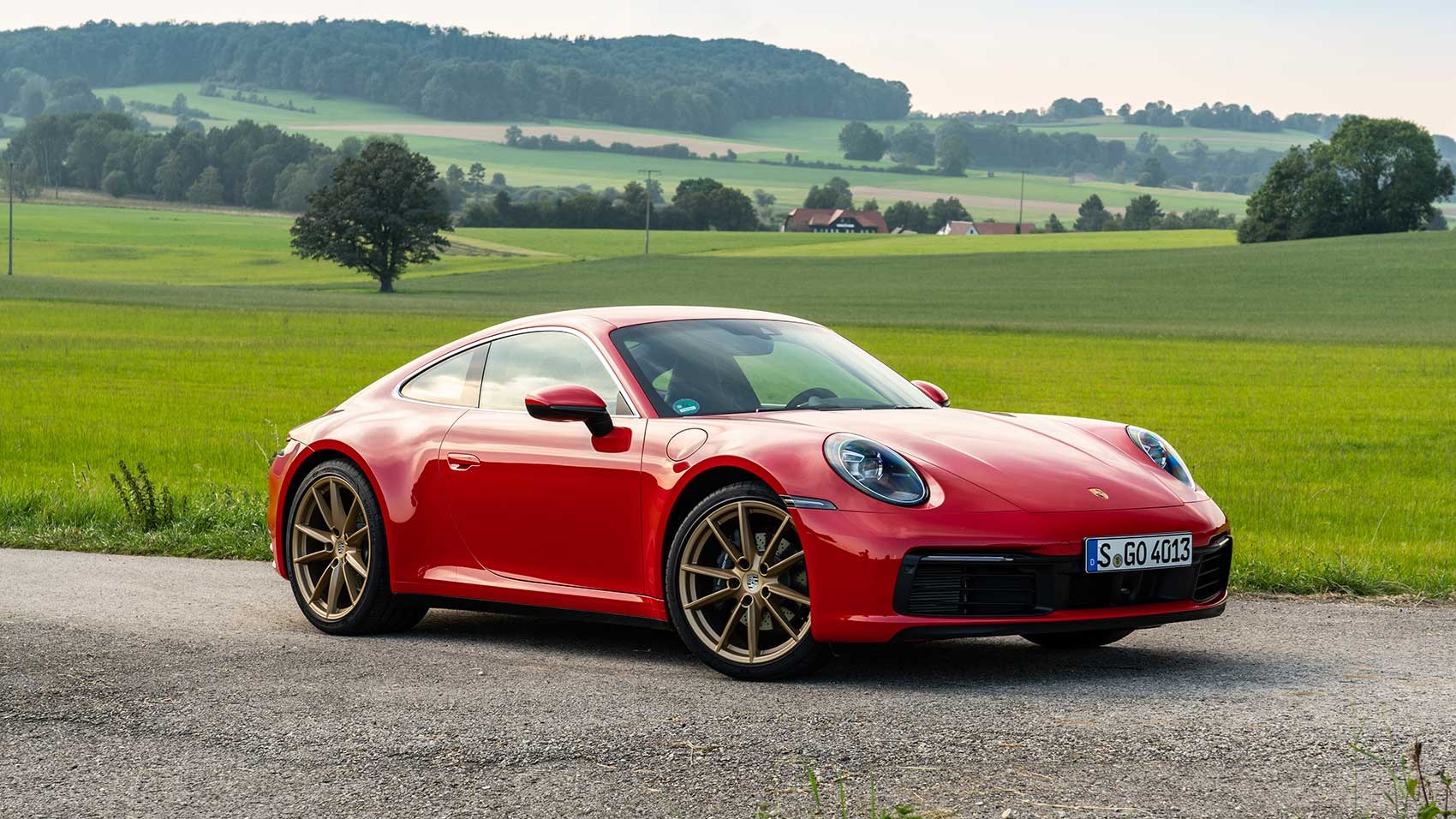
Such muscular numbers (and bodyshell) are a reminder that this is hardly a poverty Pork: 0-62mph takes just 4.2 seconds and top speed stands at 182mph. Spec the optional Sport Chrono Package and it becomes a 4.0sec 0-62mph car. Think about that for a moment… turbocharging has transformed our parameters for performance, even on entry-level models. Combined fuel economy ranges from 26.6-28.5mpg and CO2 stretches from 206-210g/km, should cutting tax bills and environmental footprint be your thing.
On the road, it’s immediately apparent that the Carrera 2 is a quick car, certainly rapid enough for the vast majority of users. Anyone wanting more will have to step up to the Carrera S (full review follows below) or one of the forthcoming Turbo or GT 911s. But we’d urge you to consider whether you really need one of those when a C2 is this rapid.
How does it feel to drive?
It’s worth pointing out that at the August 2019 launch all the C2s were fitted with optional bigger 20/21-inch wheels; the standard fitment is 19/20in rims. Even on the bigger alloys, the Carrera rides beautifully, soaking up irregularities in the road with a well-cushioned plump. The 911’s grand touring skills have never been stronger, on this evidence.
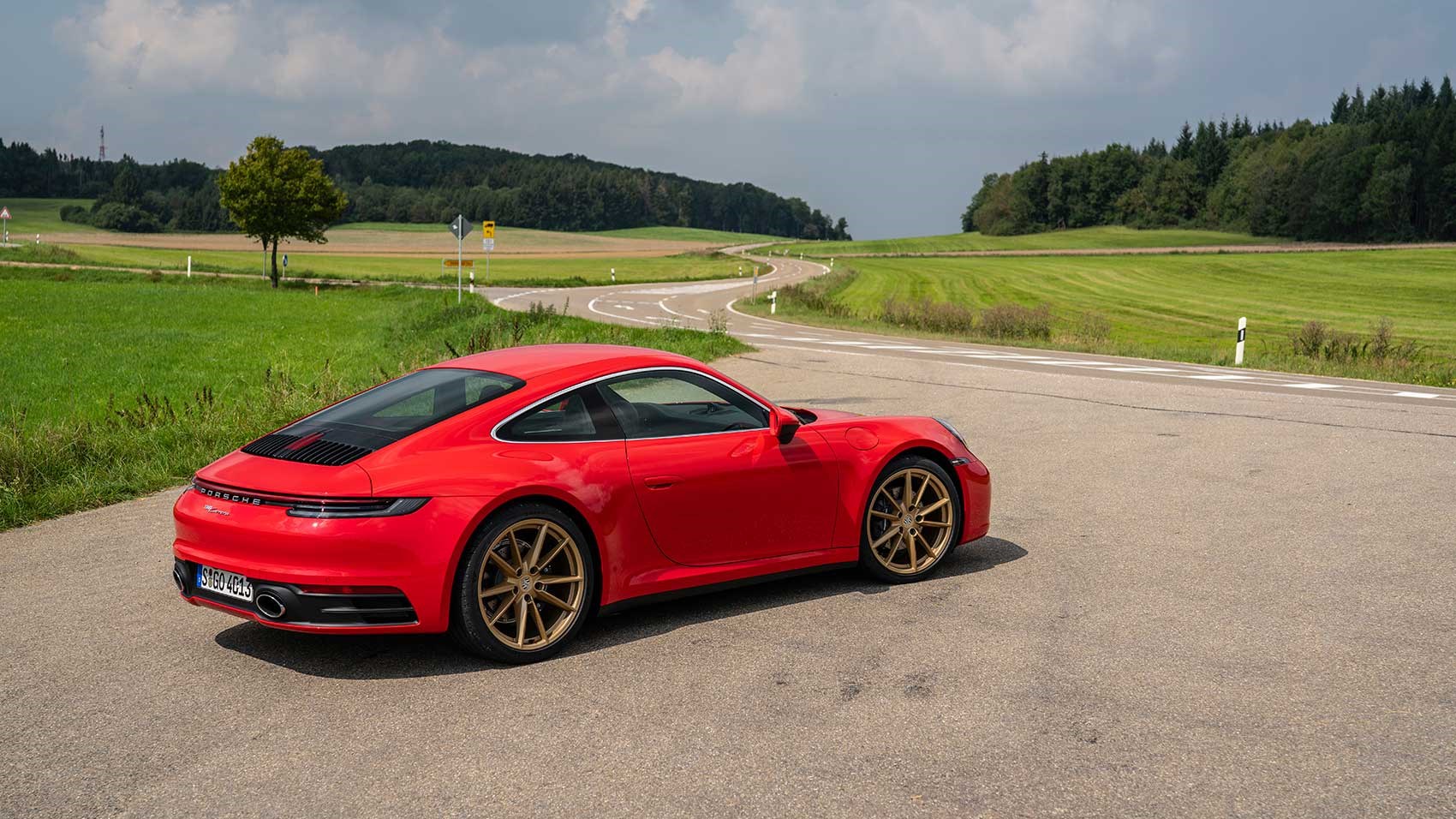
There is no manual Porsche 992 yet; it’s coming in spring 2020, keeping the unusual, ZF-supplied seven-speed DIY stick shift. All the cars driven so far have stuck with the eight-speed PDK twin-clutch transmission (also supplied by ZF). It’s a fine accompaniment to the 3.0 flat six – all smooth, slurry gearchanges around town, but up the pace and you can hammer changes home yourself via the standard paddle-shifts. Choose from Normal, Sport or Sport Plus modes, depending on what level of alertness you desire (full bore upshifts in Sport Plus come with a head-jerking ker-thunk).
It’s a satisfying car to drive, and although it’s grown alarmingly in recent iterations, the 992 is still easy to place on the road if lacking earlier 911s’ narrow gap-lunging creds. If we have one criticism it’s that the Carrera 2 is almost too sensible for its own good. The steering is quick enough and accurate, but lacks a little feel, and those twin turbochargers undeniably strangle some of the emotion from the flat six. It’s unbelievably quiet under normal driving conditions.
Select the Porsche Sports Exhaust and it still fizzes near the redline, but you’ll need to wait for a GT3 for a proper naturally aspirated screamer. Such is the price of progress.
What else do we need to know about the new 992 Carrera 2?
The interior is a revelation in 911 circles: the growth spurt makes it truly roomy and the high-quality interior is festooned with technology – much of it standard (10.9-inch touchscreen, connectivity and Wet Mode), or optional (night vision, radar cruise control and more gadgetry).
One of the test cars we drove had the optional sunroof, which bathes the cabin in daylight most pleasantly. But one glitch to watch out for: spec the optional GT sports steering wheel (as below) and you can’t see the two outer dials at all. A poor oversight. And we’re still not sure about the new pop-out door handles…
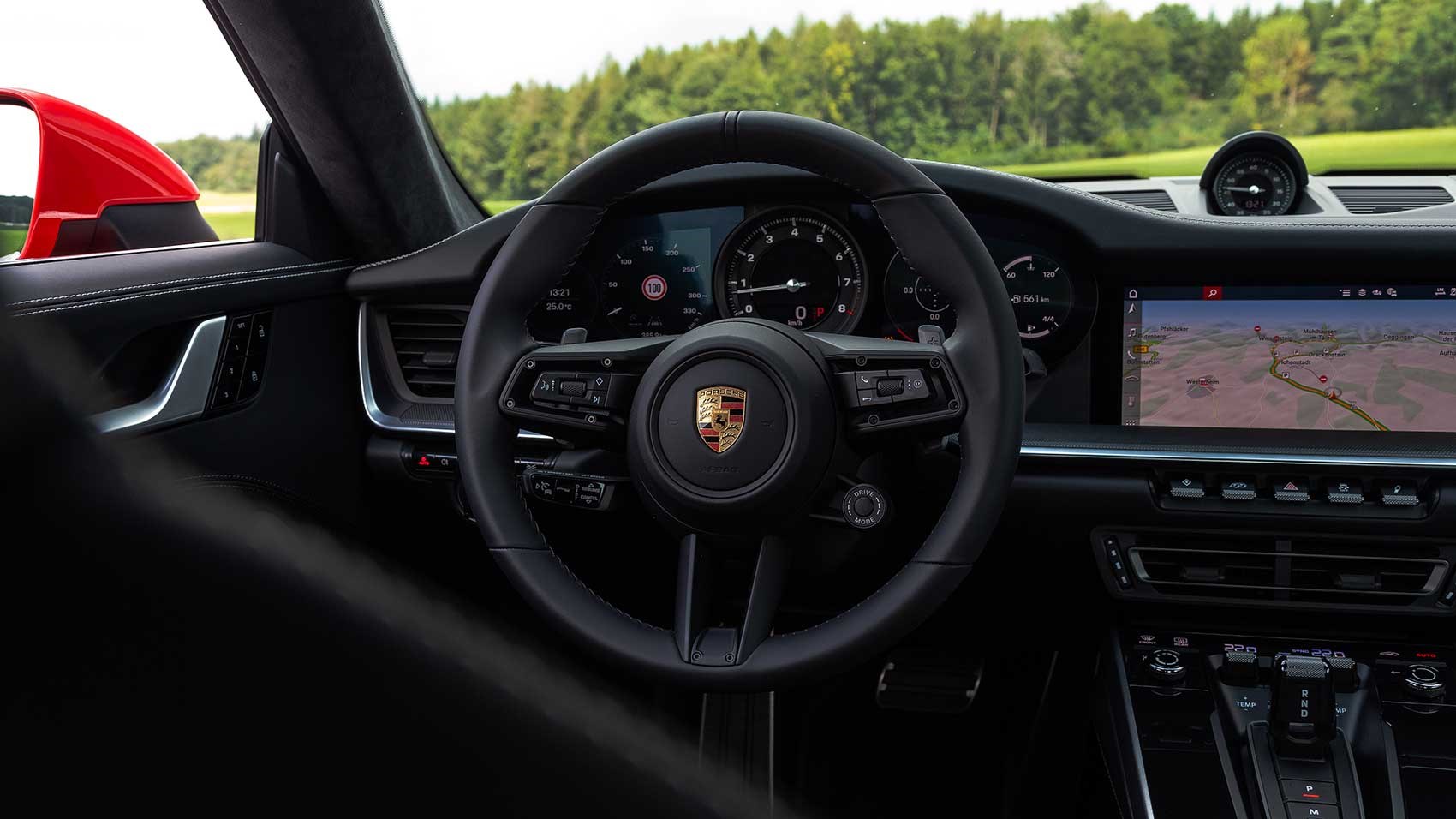
We drove cars equipped with the new optional 90-litre fuel tank (previously the reserve of the GT2). It’s a new option on all 992s and meant our range was showing as more than 450 miles. A joyful addition for those long-distance commuters among us.
Is it worth paying £10,317 more for an S? It depends on what you need from a 911: purists will doubtless justify the step-up to a Carrera S or wait for the inevitable GT3, but those wanting a rounded, fast and highly desirable sporting all-rounder won’t be disappointed. The problem is that Carreras are just a gateway drug for purer, harder, more thrilling 911s…
Read on for our earlier test of the 911 Carrera S, from the international launch in winter 2018, to help you decide. And you can read about the 911 Cabriolet in our separate review here.
Porsche 911 review: what about the Carrera S and the rest of the range?
At a glance the latest 992-generation Porsche 911 doesn’t look like a new 911. That, you could argue, means Porsche has failed. But Porsche would argue the opposite is true. Modern without being vogueish, relevant while also standing apart – these are the contradictions at the heart of the 911’s unique appeal, not to mention its longevity and rampant success.
This most evergreen of sports cars has been on sale uninterrupted for 55 years, don’t forget.
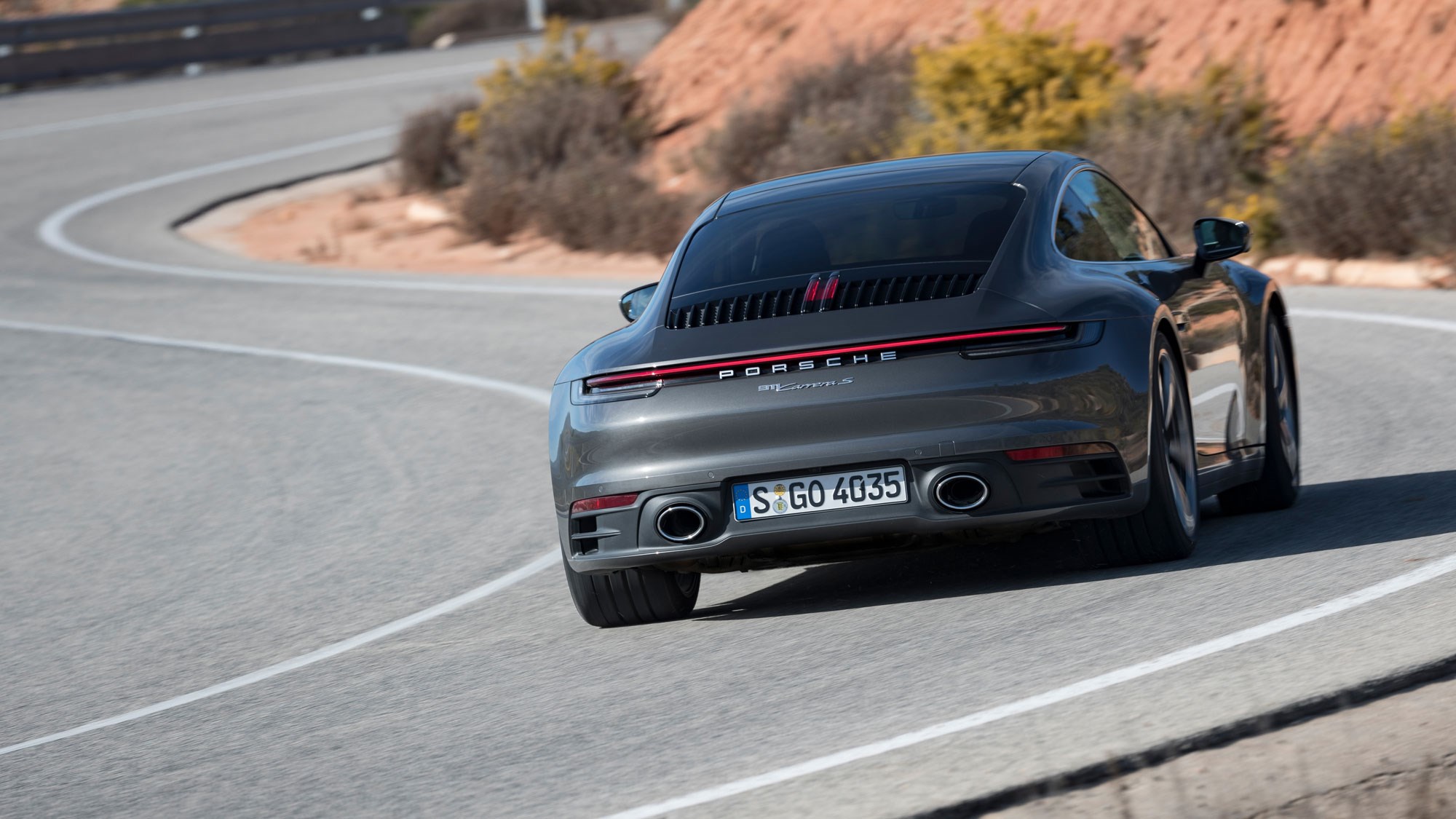
And so to the 992-generation car, which has introduced a dizzying raft of technology, from electronically controlled turbo wastegates to frameless floating instrument displays, Wet Handling modes to thermal imaging night vision, but that also gleefully pinches design influences from its past. Undoubtedly more complex and advanced than the outgoing 991.2, is the new car actually better? And by a margin that makes any material difference? Let’s find out in our fully updated Porsche 911 review.
Porsche 911 interior: the same, but better
Only Porsche would engineer an all-new bodyshell – primarily now in aluminium (70%), a 911 first (the 991’s was 37% aluminium) – great swathes of the world’s population can’t tell apart from the old one, but it’s lighter, stiffer and, to these eyes at least, prettier (rear aspect excluded), and gets even better looking when you open the door and drop inside.
The new seats are slimmer, lighter, set lower and comfier. They are, effectively, perfect. The driving position is the same. And, in the right spec, the 911 now boasts a genuinely gorgeous interior for the first time that we can recall – and all models get those wide hips swelling in your door mirrors.
CAR magazine lives with a used 997-generation Porsche 911: our long-term test review
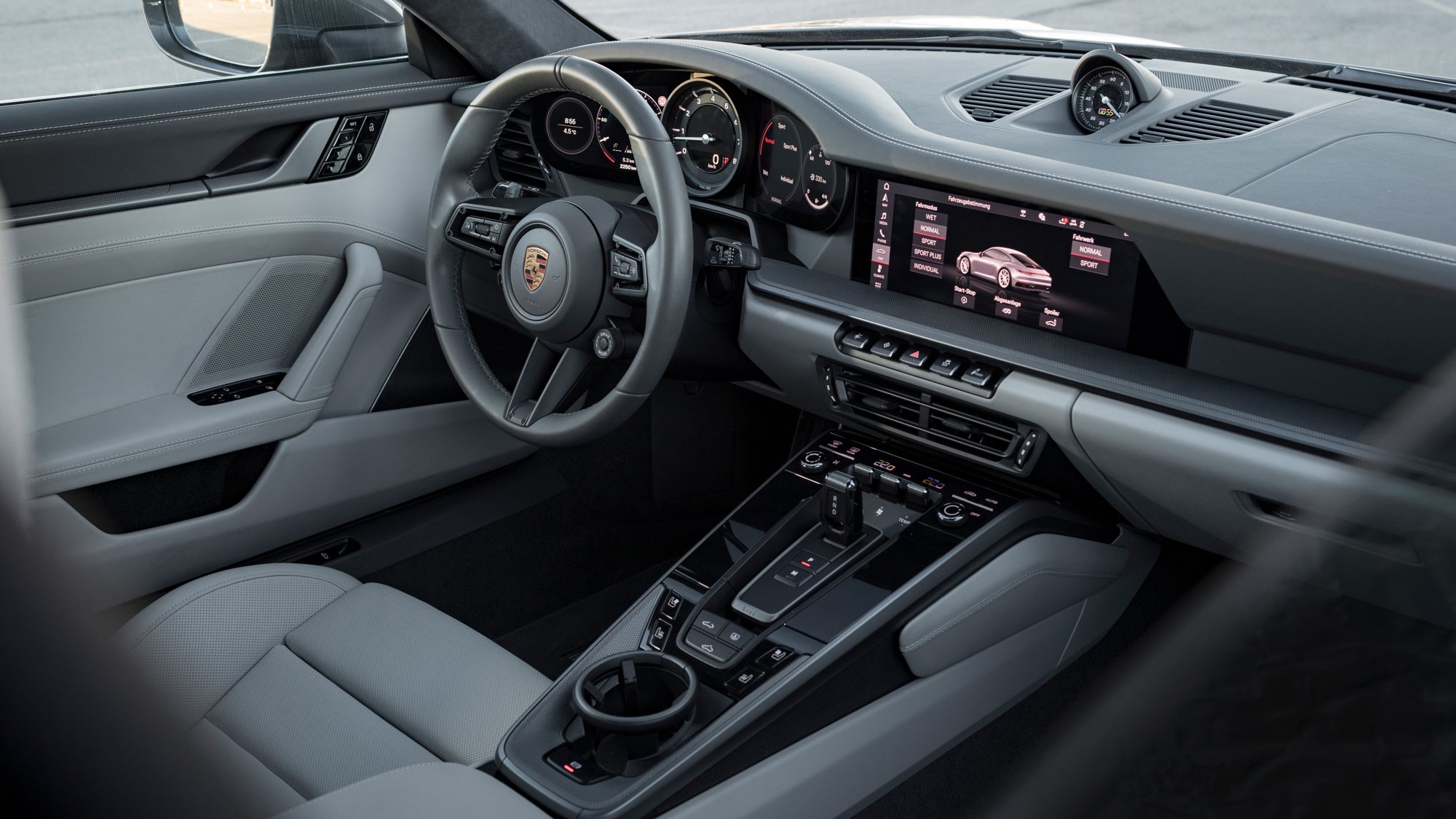
The super-simple dash and cabin architecture is concept-car cool and minimal, with bold, uncluttered horizontals, a smart gloss black centre console, an ace row of military looking toggle switches for functions like stability control and hazard lights (unrelated, obviously…) and the striking new driver’s instruments, which flank the bold analogue rev counter with digital displays.
These offer a range of functionality, from a thermal imaging forward feed to a nav map, and go some way toward mitigating the 992’s lack of a head-up display.
The new cockpit design gives the 992 a chameleon-like split personality; choose dark greys and metal finishes for a techy vibe, or throw in some wood and oxblood leather for something achingly cool and retro. You can naturally spec all manner of coloured seatbelts too.
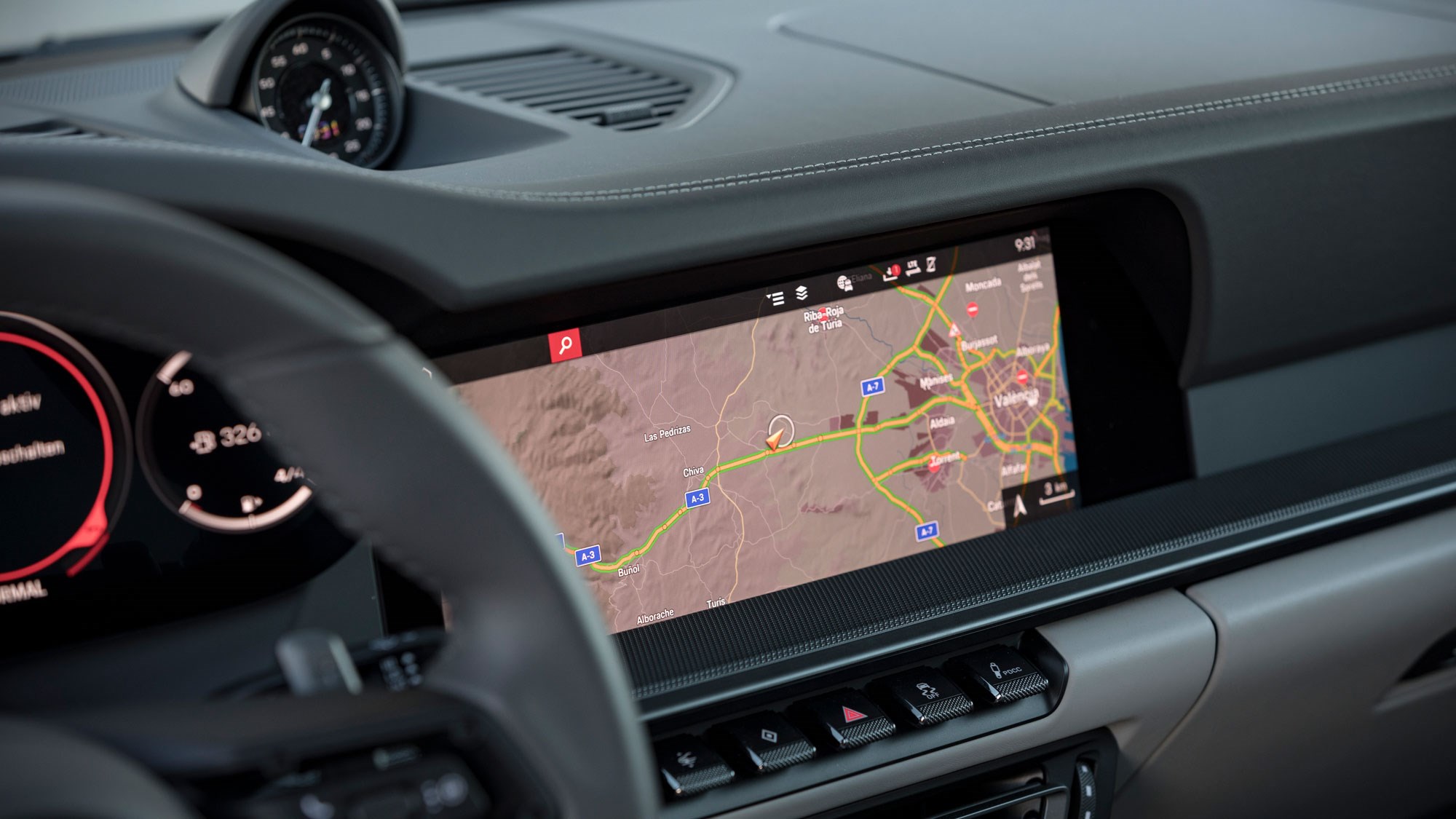
So, it’s nice in here. Does it work? Broadly, yes. The Sport Chrono pack’s drive mode controller is a step backwards. Toggling between modes, you now have to keep an eye on the display rather than simply choosing from modes marked on the control. And let’s not even get started on the ‘motorsport inspired’ 20-second full everything powertrain nonsense. While the main interface is a touchscreen, with all the compromises that implies (especially in a sports car), it is at least a handsome, crisp and responsive touchscreen (smart too, enlarging tiles and offering options as your finger approached), and one that plays no small part in the 911’s newfound interior calm and classiness.
How Porsche Wet mode stops the new 911 aquaplaning
No manual gearlever? It’s coming, but not until early 2020, so for now it’s PDK auto only. Our man Georg Kacher has tried the manual though, and while the seven-speeder is improved, it’s still not as good as it should be – let alone as good as the GT cars’ six-speeder. Stay tuned for our full Porsche 992 manual review in due course.
Can we get moving now please?
Absolutely – but are you prepared for just how quickly we’re now able to get moving? The 991 Carreras weren’t slow cars but the 992 seriously shifts. Select Drive and manual shifting for the (now eight-speed) PDK box and pop her into Sport or Sport Plus: mash it. The Carrera S’s fulsome 391lb ft and 444bhp almost instantaneously get to work on those huge new 21-inch wheels and, in the Carrera S with the Sport Chrono pack, 62mph comes up in just 3.5sec. The similarly equipped 4S will do it in 3.4sec. It’s all just numbers, sure, but be in no doubt: base 911 performance has gone up a notch.

On the road it’s an ever-present ally, this new engine, forever ready with convincing drive and always dusting your progress with turbo noises like whooshing turbines, fluttering wastegates and sonorous moans. More responsive than before? Perhaps, a touch, and this flat-six certainly feels more comfortable and smooth at lower revs, despite the higher compression ratio – perhaps a result of the new asymmetrical valve actuation, employed here to create swirl and improve fuel/air mixing at lower engine speeds.
Detail engine upgrades, then, though the performance lift over the outgoing S is significant and, coupled with the new eight-speed gearbox (with a shorter first and seventh and eighth as overdrives effectively), the new powertrain is almost impossible to catch out. On tortuous Spanish hill roads it thuds out of hairpins, gently over-rotating even warm P Zero Pirellis on a brush of throttle, before yelping from 4000rpm to just north of 7000rpm (the redline starts at 7400rpm; the limiter’s at 7500) in a spectacular display of drivability and simple, apparently effortless power. It even sounds quite good, if nothing like as good as recent non-turbo sixes, inevitably.
Does the Carrera S have too much engine for the chassis?
Not a bit of it, thankfully, though at first, as you put in some motorway miles to get to the good stuff, you’re worried Zuffenhausen accidentally built a GT. After all, the cabin now feels too slick and plush for a mere sports car, and the ride’s so impressively pliant – even on a 21-inch rear wheel, and with the more purposeful optional 10mm suspension drop – that you worry the 911’s gone soft. (The impressive ride is due in part to the lower pressures the bigger rear tyres can run, together with a new generation of adaptive damper).
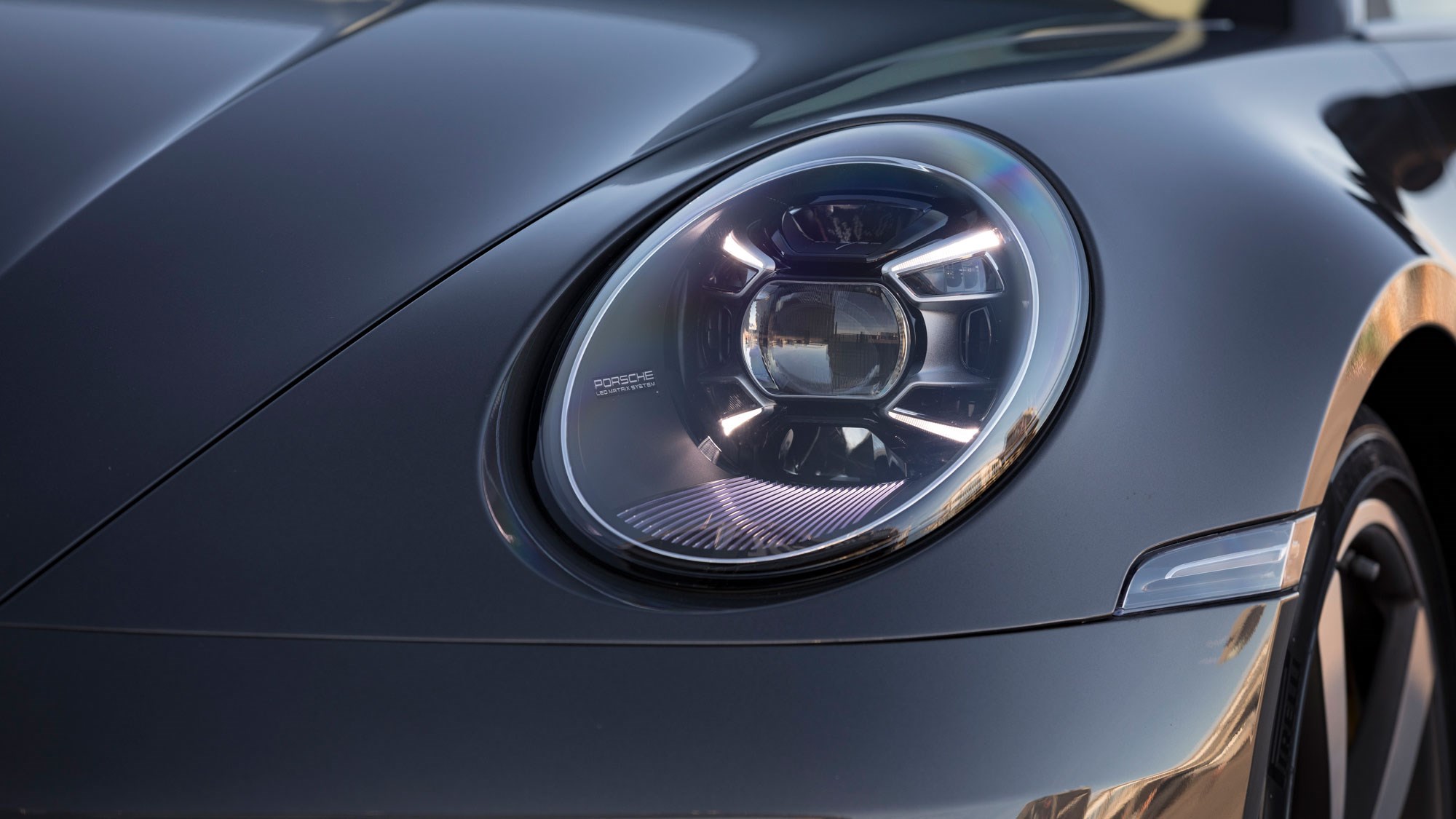
Leave the Drive Mode in Normal and the PDK box will also do its level best to hide the engine’s power, always reaching for the tallest possible ratio like a kid stretching for what it knows it can’t have. It’s quiet in here, too; really quiet. The smart new wing mirrors generate next to no turbulence, and even the roar of those huge rear tyres is well suppressed. Days at the wheel? You could do weeks in here, and still not want to get out. Oh, and there’s a new Wet mode too, for trickier conditions.
But the sports car is in there. Find some space, nudge into Sport, manual and the slacker Sport stability programme, go. The new powertrain piles on speed in a heartbeat (overtaking is child’s play), and soon you’re running into tight hairpins and fiendish little sequences at quite a rate. The brakes – ceramics on the 4S we tested, steels on the S, and with a more direct ratio and bigger rear discs on both – are supremely strong and feelsome, and able to handle it all, from walking pace town stuff to serious, speed-slaughtering stops.
Get into the first few corners and you can’t help but feel you’ve accidentally been handed a not-yet-unveiled GTS (it’ll surely come) wearing the wrong badges. Front track width is up, boosting front-end grip and confidence, and the rack is quicker – now just 2.5 turns lock-to-lock, albeit with a variable rate on our Power Steering Plus-equipped test car (£185). And while grip at both ends is improved, it’s at the front that you really feel it, that telepathic, reassuringly accurate wheel delivering a change of direction from a front axle zealous in its dedication to catering for your every whim. So you lean on it harder and harder, running optimistic entry speeds with nothing more complicated than a lift of the throttle and a roll of the wheel – and you’re through and gone.
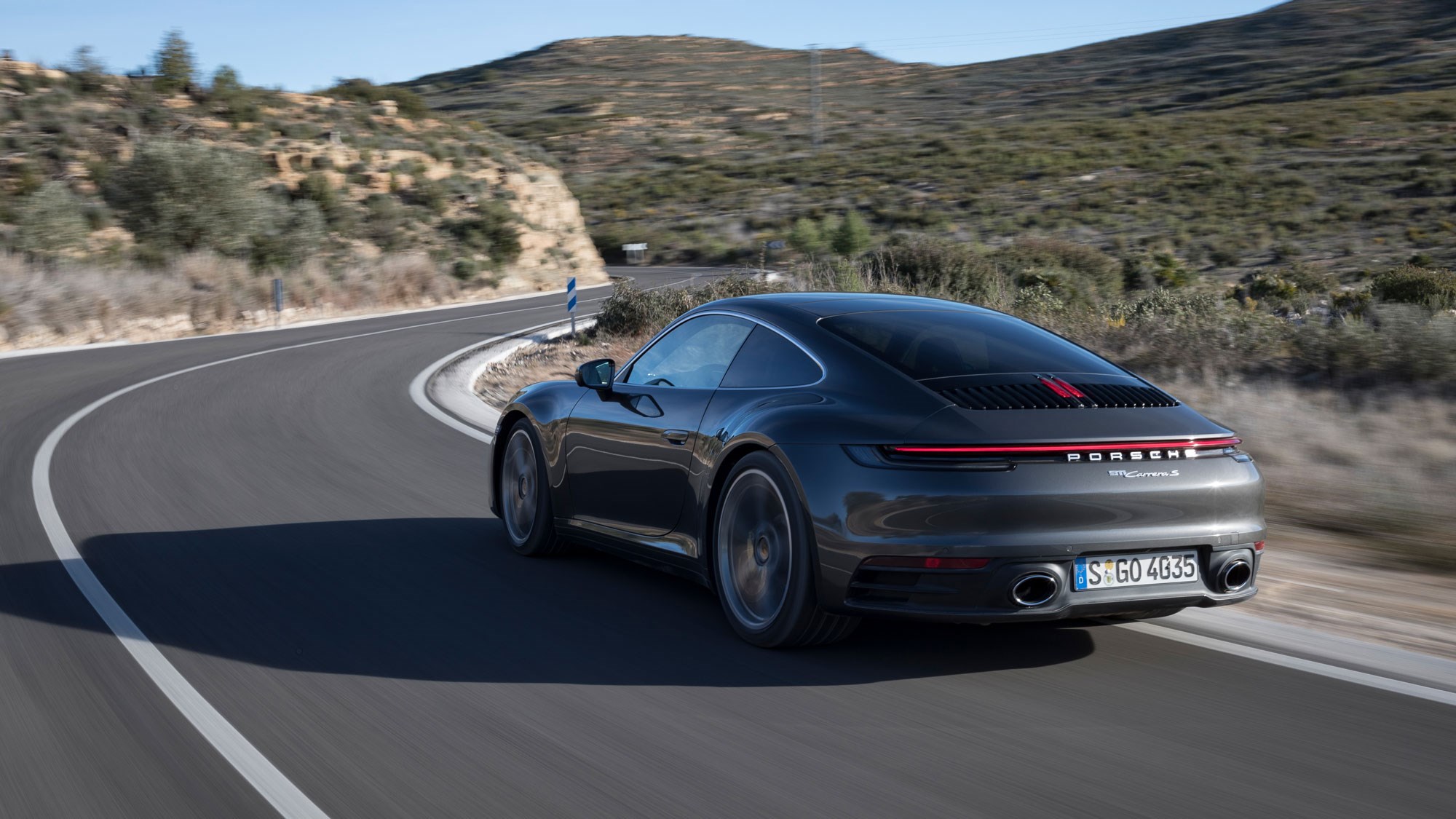
But the 992 hasn’t forgotten how to be a 911. It still feels uniquely centre-pivoted, and its balance and attitude are still hardwired to wheel and pedals in that uniquely satisfying 911 way, the car delighted to be rotated on the brakes (in the dry, understeer barely enters the equation on the road, and is progressive and easily mitigated on track), ferociously grippy through the turn and blessed with so much corner-exit grip a clean exit is always an option (as is a less clean, slightly more fun one…).
So it handles. Almost more impressive is that the 992 does so while never feeling in any way digital or synthetic – a miracle given the myriad systems involved, from the optional rear-wheel steering (£1592) to adaptive dampers (standard – the 10mm lower Sport set-up is £665), active anti-roll bars (PDDC, optional, £2273) to a torque-vectoring diff (standard). The net result is a car of such towering ability and appeal that it effectively broadens its remit. You could cover hundreds of miles cross-country without really trying, using the Porsche as a Very Good Normal Car. But it’s also so rewarding to thrash you’ll be up early and out every summer Sunday morning just to feel it do its thing one more time.
There’s got to be something wrong with it?
Agreed, though the advantage of developing the same car for half a century is surely a product that can’t help but be good by now – and the 992 is good. But its engine could sound better, certainly, the touchscreen interface could be more intuitive, less cluttered and less obtuse (there’s so much going on even the Home screen can’t show all the main functions at once – you have to scroll down through a column of them), the steering could be brighter and a little lighter, the voice recognition system could work full-stop, and the rear end could be better looking.
It could also have a manual gearbox option from launch, and a really good six-speeder in place of the compromised seven-speed it will get. It could also be cheaper too, of course (lay into those options and it’s easy to skip over £100k – we’ll drill into which ones you really need in the near future). But if this all sounds a little like nit-picking there’s a good reason for that.
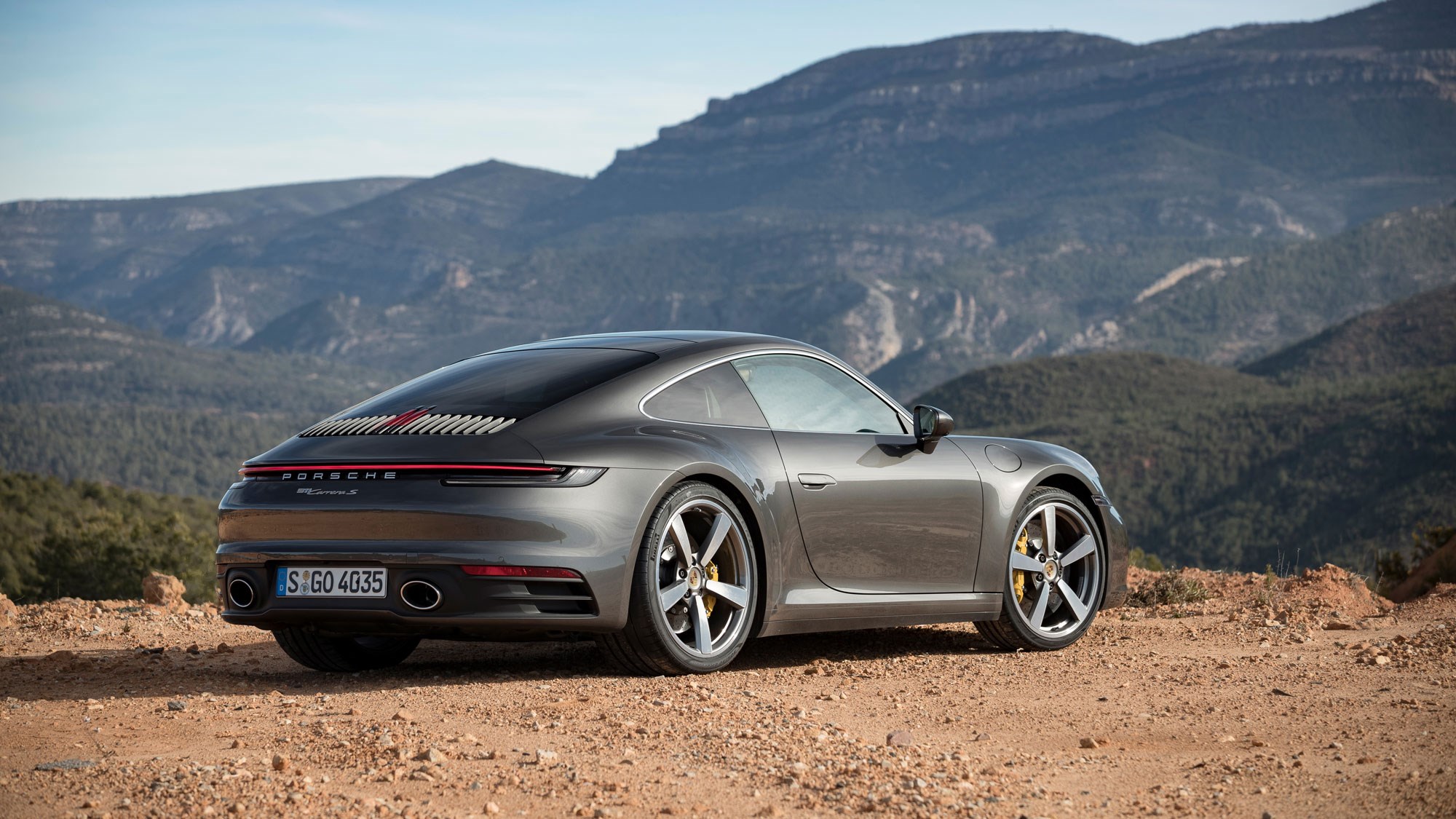
New Porsche 911 (992): verdict
Perhaps the most amazing thing about Porsche’s 911 is that so few choose to directly challenge it. Who doesn’t want a pretty, fairly practical £95k coupe able to be pretty much anything you’d like it to be; feelgood daily, track tool, special GT or an enviably bold family car set to become part of the family? All but unchallenged, Porsche could have phoned-in the 992.
But spend a few days digging into the substance beneath the 992’s admittedly familiar surface and you appreciate the effort that’s gone into every detail of the thing, from the more responsive turbos’ cleaner plumbing to the stunning cockpit’s design and materials splendour. And while modernity’s arrived in the form of keyless go, the new displays, particulate filters and an ‘uncrashable’ Wet mode, the sports car within survives intact.
The 992 isn’t flawless, and there’s plenty of scope for further development in any number of directions, from Turbo to GT3. But this 911 in Carrera S form is superb, and now we’ve driven the Carrera too we’d stump up the extra £10k needed to climb up from the base spec. A wickedly capable and rewarding driving tool, convincingly versatile like few rival sports cars and painfully desirable, it’s a masterful reinvention of a timeless concept. Furious at five stars sprinkled across the board (or scores of at least 80% in each area, which the car surely deserves)? Don’t be. Drive it.
Further reading
How the new 911’s Wet mode works
The Porsche 911 range explained
New Porsche 911: all the key info on the 992